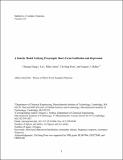| dc.contributor.author | Lee, Chuang-Chung J. | en_US |
| dc.contributor.author | Anton, Mihai | en_US |
| dc.contributor.author | Poon, Chi-Sang | en_US |
| dc.contributor.author | McRae, Gregory J. | en_US |
| dc.date.accessioned | 2009-10-19T13:29:30Z | |
| dc.date.available | 2009-10-19T13:29:30Z | |
| dc.date.issued | 2009-06 | en_US |
| dc.date.submitted | 2008-07 | en_US |
| dc.identifier.issn | 1573-6873 | en_US |
| dc.identifier.issn | 0929-5313 | en_US |
| dc.identifier.uri | http://hdl.handle.net/1721.1/49454 | |
| dc.description.abstract | Short-term facilitation and depression refer to the increase and decrease of synaptic strength under repetitive stimuli within a timescale of milliseconds to seconds. This phenomenon has been attributed to primarily presynaptic mechanisms such as calcium-dependent transmitter release and presynaptic vesicle depletion. Previous modeling studies that aimed to integrate the complex short-term facilitation and short-term depression data derived from varying synapses have relied on computer simulation or abstract mathematical approaches. Here, we propose a unified theory of synaptic short-term plasticity based on realistic yet tractable and testable model descriptions of the underlying intracellular biochemical processes. Analysis of the model equations leads to a closed-form solution of the resonance frequency, a function of several critical biophysical parameters, as the single key indicator of the propensity for synaptic facilitation or depression under repetitive stimuli. This integrative model is supported by a broad range of transient and frequency response experimental data including those from facilitating, depressing or mixed-mode synapses. Specifically, the theory predicts that high calcium initial concentration and large gain of calcium action result in low resonance frequency and hence depressing behavior. In contrast, for synapses that are less sensitive to calcium or have higher recovery rate, resonance frequency becomes higher and thus facilitation prevails. The notion of resonance frequency therefore allows valuable quantitative parametric assessment of the contributions of various presynaptic mechanisms to the directionality of synaptic short-term plasticity. Thus, the model provides the reasons behind the switching behavior between facilitation and depression observed in experiments. New experiments are also suggested to control the short-term synaptic signal processing through adjusting the resonance frequency and bandwidth. | en_US |
| dc.language.iso | en_US | en_US |
| dc.publisher | Springer Netherlands | en_US |
| dc.relation.isversionof | http://dx.doi.org/10.1007/s10827-008-0122-6 | en_US |
| dc.rights | Article is made available in accordance with the publisher's policy and may be subject to US copyright law. Please refer to the publisher's site for terms of use. | en_US |
| dc.rights.uri | | en_US |
| dc.source | C. C. J. Lee | en_US |
| dc.subject | resonance frequency | en_US |
| dc.subject | frequency response | en_US |
| dc.subject | transmitter release | en_US |
| dc.subject | short-term depression | en_US |
| dc.title | A Kinetic Model Unifying Presynaptic Short-Term Facilitation and Depression | en_US |
| dc.type | Article | en_US |
| dc.identifier.citation | C. Lee, M. Anton, C. Poon, and G. McRae, “A kinetic model unifying presynaptic short-term facilitation and depression,” Journal of Computational Neuroscience, vol. 26, Jun. 2009, pp. 459-473. | en_US |
| dc.contributor.department | Harvard University--MIT Division of Health Sciences and Technology | en_US |
| dc.contributor.department | Massachusetts Institute of Technology. Department of Chemical Engineering | en_US |
| dc.contributor.approver | Poon, Chi-Sang | en_US |
| dc.contributor.mitauthor | Poon, Chi-Sang | en_US |
| dc.contributor.mitauthor | Lee, Chuang-Chung J. | en_US |
| dc.contributor.mitauthor | Anton, Mihai | en_US |
| dc.contributor.mitauthor | McRae, Gregory J. | en_US |
| dc.relation.journal | Journal of Computational Neuroscience | en_US |
| dc.eprint.version | Author's final manuscript | |
| dc.type.uri | http://purl.org/eprint/type/SubmittedJournalArticle | en_US |
| eprint.status | http://purl.org/eprint/status/PeerReviewed | en_US |
| dspace.orderedauthors | Lee, Chuang-Chung J.; Anton, Mihai; Poon, Chi-Sang; McRae, Gregory J. | en |
| dc.identifier.orcid | https://orcid.org/0000-0001-9814-8895 | |
| mit.license | PUBLISHER_POLICY | en_US |
| mit.metadata.status | Complete | |
